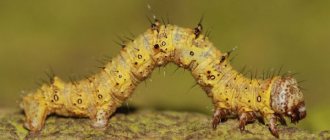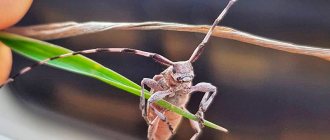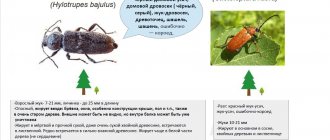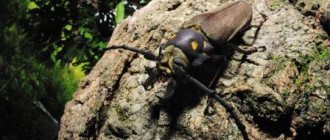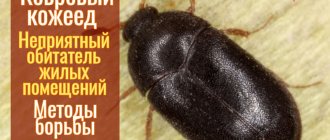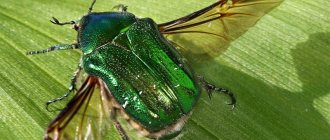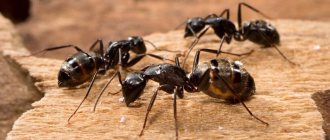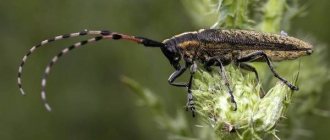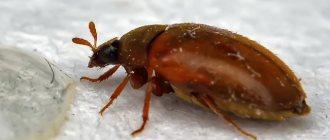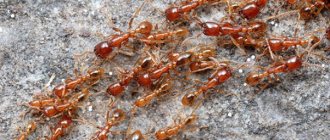In any place, be it a private house or a city dwelling, you can find an insect of different sizes, called the woodcutter beetle - from millimeters to several cm. It is distinguished by the dark color of its outer cover with an iridescence in blue-green tones, but its main difference is its mustache, which are many times greater than their owner. This is a longhorn beetle, or woodcutter, belonging to the most ancient and widespread order of beetles. Representatives of this species were found living in the Jurassic period, i.e. 145 million years ago. It will not cause damage to humans directly, but will damage wooden furniture and partitions.
The structure of the insect's body is as follows:
- antennae are scaly or serrated, located on the sides of the eyes, in the frontal zone, they are 4-6 times longer than the body;
- head with powerful, well-formed front jaws and compound eyes located on the sides;
- the body has three fragments - chest, back, plastic abdomen; in males it is more elongated, pointed, in females it is rounded and thicker; the pattern of the body varies and consists of so-called fetters, spots and stripes;
- elytra and iridescent wings; some representatives of this species have lost the ability to fly, for others, gliding in the air is slow and difficult, others fly easily, quickly, without stress;
- the limbs are five-segmented, where the front pair of legs is much shorter than the last.
Continuation of life
Longhorn beetles breed in areas where there is silence and at altitude.
An excellent place - roof crossbars, tall trees. This is where mating takes place. During the mating season, females secrete a special liquid that is attractive to the “male half”. Insects are not averse to sexual games lasting up to half an hour. The fertilized individual is looking for a secluded place for a nest in order to lay a clutch in the future. There can be more than a hundred eggs in one place. Soon the adult dies. Her life on average lasts up to a month.
The male does not leave the female, he moves after her and waits for offspring. After two weeks, voracious larvae hatch. Everything that surrounds them serves as food for them.
Habitat
The habitats of woodcutter beetles are as diverse as their species. Their favorite places are tree trunks, bushes, herbaceous plants and even wooden houses.
Many people believe that longhorned beetles are dangerous to trees. However, it is not. After all, beetles lay their eggs exclusively in damaged wood or weak trees. Typically, lumberjacks can be found in large numbers in areas of massive deforestation.
Of course, laying their eggs in damaged, weakened trees. Gnawing through cracks and grooves. And in the future, if the larva gnaws through the tunnels from the inside, then such a tree will lose any chance of survival.
It is not uncommon to encounter woodcutter beetles in your dacha. And this meeting will not be very friendly. After all, their larvae can take a fancy to your furniture and other products that are made of wood. In this case, there is an additional headache in removing these pests.
What happens to the larvae
This can be said about light or milky-colored, fleshy-yellow larvae of a flattened shape. Convex limbs allow future insects to move along the surface. The head is black with healthy jaws. With them they easily gnaw the inside of the tree, so they have enough nutrition. Gradually, only dust remains from the tree trunks. Then the larva will have to look for a new place of “residence”.
Those who live in the grass, on plant stems, have an elongated long body, similar to a cylinder, with hairs at the ends of the body.
Well formed sternum. The gluttony of the larvae is amazing - in a day they can increase their mass to twice their original weight. This law of nature operates to produce a full-fledged beetle, because... on summer days, a mature individual eats practically nothing - just grass and flowers. Moments were noted when bark beetle larvae completely destroyed human wooden buildings located in one block. Autumn is coming to an end. The beginning of winter is the time of pupation of the larvae. Spring is the stage of metamorphosis of a beetle into an adult insect. If the larva is hidden deep in the plant and is reliably protected, then the individual can survive in this state for decades. The fact of drilling a “passage” of up to 50 km has been recorded, taking into account the fact that up to 3 cm of wood is gnawed per day.
The free pupal stage lasts about 40 days. The color of the body changes, yellowness appears, the rudiments of wings and antennae are visible, the limbs are closely pressed. The head is located almost at the chest, the antennae are hidden between the legs. The pupae may have spines and short hairs.
The larva first builds a shelter in a tree trunk, ground, stems, and pupation begins there.
Morphological description of the species
The house woodcutter or black house woodcutter (Hylotrupesbajulus) is a common species of beetle from the longhorned beetle family. The adult size is small, 7-21 mm. The body is flattened, black, covered with short grayish hairs. The head has coarse, dense punctures, and a longitudinal groove between the antennae. The head is also covered with gray hairs. The eyes are deeply notched. The antennae are thin, shortened, reaching only the middle of the elytra.
In most beetles, the oval transverse pronotum is densely covered with hairs. At the base the punctures are fine and the hairs are short. On the sides the punctation is denser and the pubescence is longer. There is a smooth strip in the middle of the shield, with convex calluses located on both sides of it. The shape of the shield is core-shaped, the back part is widely rounded. The hard elytra are covered with wrinkled punctures. On their surface, gray hairs form several clusters in the form of uneven spots.
The limbs are well developed and consist of 5 parts. The fore coxae are widely separated. The tarsus has 5 segments, the third is divided into two parts, ending in two claws. The hind legs are longer than the front ones. On the underside of the body there are two types of light hairs - semi-adjacent and erect.
Variation in appearance
Longhorned beetles are characterized by variability in the color of the elytra, the sculpture of the scutellum, and the distribution of hairs. Beetles living in the south are distinguished by light-colored elytra - brownish-yellow or pale yellow. The calluses on the pronotum are elongated and rounded. In various forms, the legs are colored black, brown or red-brown.
Are insects capable of flight?
Longhorned beetles are large insects.
It's hard for them to fly. Maneuvering requires speed, landing successfully requires effort. When flying, they emit a sound that is clearly audible. Location and weather conditions influence the beginning of takeoffs - in southern latitudes this is the beginning of spring, in the middle zone - the first two months of summer. Insects of Asian countries prefer autumn. Many are active during the day when it is hot. Some species leave their shelter overnight.
The flight function is needed to search for food. Females and males have different desires for flights, everything here is determined by the species.
What danger do these beetles pose?
The main food of insects is bark and various vegetation. They do not bite or harm people. But the bark beetle will ruin human property. Becoming a mature individual from a pupa, the beetle makes a move to come out. If rot and white powdery deposits are noticed on wood structures, this is a sign of an undesirable neighbor. In wood inhabited by pests, you can find numerous passages; a sharp object effortlessly enters the thickness of such a tree.
When it’s completely quiet, you hear a rustling, clicking sound that resembles ticking.
This sound is made by gnawing beetles located behind the bark during the day. At night, “crackling” occurs from larvae that hide in the thickness of wooden objects. The bark beetle will also use its unpleasant creaking tone as a defense when an enemy attacks them. The larva causes the greatest harm to wooden buildings, because it lives inside and destroys the structure. Even after the death of a tree, the larvae continue to live in it, finding food there.
Life cycle and nutrition of longhorned beetles
The longhorned beetle has a life cycle of 1 to 2 years depending on the species. During this period they go through several stages:
- egg;
- larva;
- chrysalis;
- imago.
The female lays eggs on the surface of the bark or substrate in which they live. These are so-called spontaneous clutches, because the insect does not particularly care about its offspring. However, some species of longhorned beetles diligently protect their eggs.
The development of larvae occurs inside wood, in grass, in plant shoots; already at this stage they eat bark. Throughout the summer period, the larvae prepare a shelter for themselves in the wood, drilling tunnels deeper into the wood. The males that appeared earlier than the females die off some time after mating. Females live until they lay eggs. On average, this period takes up to 3 months.
Longhorned beetles can live in the larval stage for 17 years, during which time they drill kilometers of tunnels into the thickness of wood. They only come to the surface when they turn into beetles.
The diet of longhorned pests depends entirely on their habitat. For example, woodcutters live in the forest zone and their main food is:
- needles;
- pollen;
- foliage;
- bark of young branches.
This diet promotes the full sexual development of insects. The black house beetle feeds mainly on wood, as it lives in residential buildings, causing damage to human property.
Getting rid of unwanted neighbors
Getting rid of bark beetles should not be delayed. At the first sign of their presence, take measures to destroy them. There are several ways to remove the pest. They are divided into:
-
Contact
. “Clipper”, “Antizhuk”, “Empire-20” are considered effective defense weapons. The substance included in their component destabilizes the possibility of reproduction - the beetles will not be able to lay eggs, and their number in the house will noticeably decrease.The preparations are poured into the cracks, then covered with plasticine. The product penetrates into the body of the barbel, inhibits its metabolic abilities, and the parasite dies. Use insecticides before starting to build a house made of timber; treat the tree annually for preventive purposes. Read the instructions carefully; the drugs require careful use because they are poisonous.
- Intestinal
. Control means are poisonous baits that attract barbels. Having tried them, the bark beetles will die.
Folk remedies
In addition to chemicals, folk remedies can be used to combat tree pests. Kerosene, turpentine and naphthalene effectively cope with the task of killing insects. They are mixed in a ratio of 1:4:1. This composition has a runny consistency, which is a deadly poison for insects.
This folk remedy is poured into holes made in wood or coated with tree trunks and affected surfaces. The beetles die from the fumes of the toxic mixture.
Preventive actions
A wooden building needs protection from insect pests.
For these purposes, when constructing a facility, provide an obstacle to woodworms. All accessories that are not yet infected (boards, beams, beams, ceilings, etc.) are treated with an antiseptic, and in several layers. Wooden buildings that have been attacked by insects should:
- Treat with dry steam
at 80 degrees. The beams dry out and the larvae die. At the same time, the texture and appearance of the wood are not destroyed + fungus and mold are destroyed, and the nasty smell disappears. Steam is able to penetrate into the most remote corners of the structure. The process is not expensive, but it is fire hazardous. The method is only suitable for attic spaces. - Treat the room using fumigation
, i.e. gas - this effective remedy will protect the tree from bark eaters. You will need a steam supply unit that will penetrate all the cracks of the infected object and kill the larvae. The gas (it is odorless) disintegrates soon and will not harm humans. After treatment, the home is ventilated for two days. - The fogation method
involves fumigating a space using a fog generator. This is a fine spray in the form of an aerosol, which contains a chemical substance. The jet hits only the wooden surface; the interior of the wood is left untreated. - An antiseptic
is poured into the passages gnawed by the larvae using a syringe. The douching method will help at the initial stage, when there are still few pests. As the anti-putrefactive drug evaporates, douching is repeated. - The current method of pest control involves Microwave irradiation
. A special device is installed. It emits waves that heat the surface. The tree becomes hot - insects die in it. Microwave disinfestation works well in areas that are difficult to reach with other methods.
To fully combat lumberjacks in your home, constantly inspect wooden objects to see if any holes or passages have appeared. Frequent ventilation of the home will eliminate excess moisture, which attracts larvae.
How to remove ants from a bathhouse
Many methods and preparations have been invented to kill ants in a bathhouse; sometimes folk remedies help. Conventionally, the procedure is divided into two methods: complete destruction or scaring away.
Destruction of the entire anthill
When insects appear, you should immediately carefully inspect the bathhouse and the surrounding area. If you manage to find a nest with ants, it must be destroyed. You can do this in the following ways:
- In an accessible place, the nest with ants is poured with boiling water. If the anthill is supposedly located under the pouring floor of the bathhouse, boiling water is poured throughout the room.
- If there is good access, the nest with ants is covered with parsley leaves. To enhance the effect, chop cloves of garlic.
- The ants are poisoned inside or near the bathhouse with a solution prepared from two glasses of washing powder, vinegar essence, and sunflower oil. The ingredients are dissolved in 1 bucket of water and poured onto the anthill.
- A small anthill can be carried with a shovel far beyond the bathhouse.
- The anthill in the bathhouse is sprinkled with special preparations, for example, “Anteater,” which eliminate insects for a long time.
Any method will give a positive result if the ants’ shelter in the bathhouse was found at an early stage. Over time, the anthill grows. In a small area, a network of many connected nests is formed, which complicates the fight against annoying ants.
Professional preparations
If the ants have managed to form many nests in the bathhouse, only chemicals will help get rid of them. Regardless of the composition, they all act the same. Bait poison is produced in granules, powders, and gels. The product is applied to the area of the bathhouse where ants most often accumulate. Insects find the drug by smell and transfer it to the anthill. The poison is consumed by the queen and the larvae. After a couple of days, all the ants die.
The most popular means of fighting ants are:
- Gel “Great Warrior” completely exterminates ants in a maximum of 14 days.
- Gel “Clean House” will destroy all ants in the bathhouse in a month.
- Granules "Grom-2" are a long-acting product. After 3 months there will not be a single ant left in the bathhouse.
Any chemical against ants is poisonous and toxic.
If used carelessly in a bathhouse, there is a risk of human poisoning.
Folk remedies
It is advisable to resort to the use of chemicals as a last resort. Less aggressive traditional methods often help clear a bathhouse of ants.
Boric acid and honey
A solution for baiting adult ants is prepared from 1 tbsp. water, 1 tbsp. l. honey, 1 tsp. boric acid powder. The resulting mixture is poured into jars and placed in all places in the bathhouse where insects appear. Every 2 days the traps are filled with fresh solution.
Attention! The dose of boric acid cannot be increased, otherwise the ants will die instantly. The insect must carry the bait to the nest and feed the queen
Sulfur checker
Ants are driven out of the bathhouse using the smoke of a special preparation. The sulfur bomb is set on fire indoors, the windows, doors, and ventilation hatches are tightly closed. After a couple of hours, the bathhouse is ventilated. Heat the stove once or twice without the presence of resting people. You can take a steam bath without ants in a week.
Ants and smells
Ants do not tolerate the specific odors of spices, herbs, and some garden crops. Aromatherapy helps get rid of insects faster. The bathhouse is heated until the temperature inside the room rises. Garlic cloves and tops, cinnamon sticks, parsley or tomato tops are laid out in all rooms. The more aroma there is, the faster the ants will leave the bathhouse. You can add wormwood or chamomile to the listed remedies.
Prevention
The best method of preventing ants is to keep the bathhouse perfectly clean. After rest, thoroughly rinse off any remaining detergents and remove any food crumbs in the rest room.
It is important to provide effective ventilation to accelerate the evaporation of moisture
